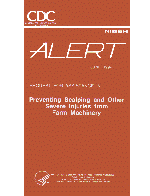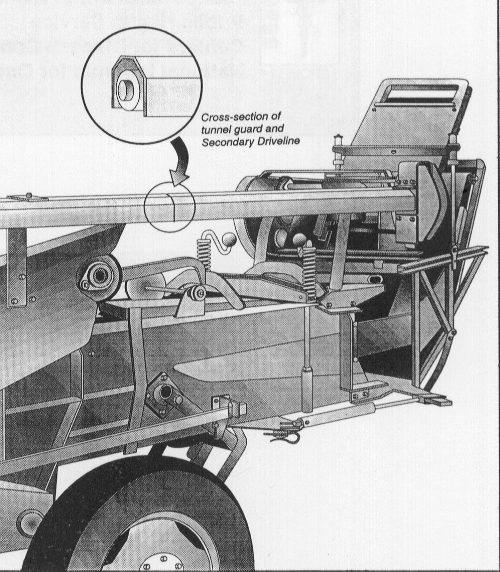
|
Request for Assistance in...Preventing Scalping and Other Severe Injuries from Farm MachineryNIOSH ALERT: June 1994 |
WARNING!
|
This Alert describes five cases of persons who were scalped when their hair became entangled around the inadequately guarded rotating drivelines or shafts of farm machinery driven by power take-offs (PTOs). Such entanglement of hair, clothing, or body parts kills and injures many farm workers each year. The recommendations in this Alert will help prevent these entanglement injuries and deaths. The National Institute for Occupational Safety and Health (NIOSH) therefore requests the assistance of county extension agents, editors of trade journals, agricultural associations, and equipment manufacturers in bringing these recommendations to the attention of farm owners, workers, and family members at risk.
Several surveillance systems collect data on farm-related entanglement injuries: the NIOSH National Traumatic Occupational Fatalities (NTOF) Surveillance System, the National Electronic Injury Surveillance System (NEISS) of the U.S. Consumer Product Safety Commission (CPSC), and the NIOSH-funded Agricultural Health Nurse Program (AHNP) of New York State.
Data from the NTOF surveillance system indicate that at least 346 farm workers aged 16 or older died from farm-related entanglement injuries between 1980 and 1989; 112 of those deaths were caused by entanglement in PTO-driven drivelines and shafts of farm machinery [NIOSH 1993].
Nearly 10,000 nonfatal entanglement injuries also occurred on farms between 1982 and 1986 [CPSC 1987]. Of these injuries, 864 included the loss of a body part.
In August 1991, the AHNP of New York State reported a case of a woman who was scalped when her hair became entangled around the secondary driveline of a hay baler. Further investigation revealed that four similar incidents had occurred in New York State between 1973 and 1991. All five cases are described in detail in the Case Reports section of this Alert.
OSHA regulations require that all rotating shafts and drivelines on equipment manufactured after 1976 be "guarded to protect against employee contact" [29 CFR 1928.57 (b)(1)(iii)]. However, the equipment involved in the incidents described here was manufactured in the early 1970s, and the standard does not therefore apply to them. In addition, these incidents occurred where the OSHA standard is not enforceable--on farms that employ fewer than 11 full-time workers.
The American Society of Agricultural Engineers (ASAE) publishes voluntary standards for the safety (ASAE S318.10) and guarding (ASAE S493) of agricultural equipment [ASAE 1992b,c]. For further information about these standards, contact the ASAE at 2950 Niles Rd., St. Joseph, MI 49085-9659; telephone, (616) 429-0300.
The New York AHNP and the NIOSH Division of Safety Research recently investigated five scalping incidents involving five female farm workers or farm family members. Each woman was scalped totally or partially when her hair became entangled around the rotating secondary driveline of hay baling equipment (see Figure 1).

Figure 1. Hay baler equipped with U-shaped tunnel guard.
In July 1991, a 47-year-old woman was baling hay on a windy day. After positioning the tractor throttle on idle but not disengaging the PTO, she dismounted and walked toward the back of the tractor past a rotating secondary driveline that powered the bale thrower. This driveline was located 4 feet above ground and was guarded by a tunnel guard (i.e., an inverted U-shaped guard) that left the underside of the driveline exposed. While the woman was at the rear of the baler, her hair (which was reportedly tied back, covered with a bandanna, and tucked inside her shirt) became entangled around the driveline. The rotating driveline tore her entire scalp from her head. These injuries required extensive skin grafting and left her permanently disfigured [CDC 1992].
In July 1990, a 30-year-old woman was baling hay with a recently purchased used baler. After recognizing a problem with the bale tension, she reduced the tractor speed to idle, dismounted from the tractor, and walked toward the rear of the baler past the driveline of the bale thrower. This secondary driveline was shielded with a tunnel guard. As the woman bent over to adjust the bale tension, her hair (which was tied back in a long ponytail) became entangled around the driveline and her entire scalp was torn from her head [CDC 1992].
In July 1981, a 42-year-old woman was leaning against a tunnel guard for the rotating driveline that powered the bale thrower on a hay baler. As she bent over to evaluate a problem with the machinery, her shoulder-length hair became entangled around the secondary driveline,and her right ear and the right side of her scalp were torn from her head [CDC 1992].
In June 1976, a 42-year-old woman who was baling hay walked toward the rear of the baler past the rotating secondary driveline of the bale thrower. The driveline was guarded by a tunnel guard. Her hair (reportedly tied in a bun) became entangled around the driveline and her entire scalp was torn from her head. She also received serious facial injuries that required extensive reconstructive surgery [CDC 1992].
In June 1973, a 12-year-old girl was walking in a hayfield while her father baled hay. Her father slowed the tractor to an idle and asked the girl to check the bale counter to see how many bales had been made. To check the counter, the girl lowered her head under a rotating, tunnel-guarded driveline that powered the bale thrower. The girl's ponytail became entangled around the driveshaft, causing the ponytail and the attached skin to be torn from her head [Roerig 1991].
All five incidents described in this Alert involved inadequately guarded drivelines and victims who were standing or walking near rotating drivelines.
The inadequately guarded drivelines involved in the five incidents described here were guarded by inverted U-shaped tunnel guards that did not completely enclose the drivelines (see Figure 1). Initially, the rotating driveline was thought to have created enough air current to have drawn the hair of the victim onto it. However, an investigation of Case No. 1 showed that the rotating driveline produced no measurable air currents. Direct contact with the shaft or driveline could nonetheless have occurred through the open portion of the U shape. In addition, the drivelines were located approximately 4 feet above the ground, limiting visibility of the hazard. Two of the victims stated that they were unaware of the exposed rotating driveline underneath the shield.
The inadequately guarded drivelines involved in the five incidents described here were associated with Models 54A, 54B, 58, and 62 of a bale thrower manufactured by New Holland [CDC 1992]. Various types of machinery produced by other manufacturers may also have U-shaped guards, especially equipment manufactured before 1976.
A retrofit safety shield kit has been available from the manufacturer for the older New Holland balers since 1976. The kit contains two plastic guards for the driveline, a safety decal, and installation instructions.
Bale throwers currently manufactured by Ford-New Holland (formerly New Holland) are equipped with a guard that fully encloses the driveline. However, the older models can remain in service for many years--even decades. A farmer purchasing used machinery would probably be unaware of any retrofit guards available from the manufacturer. Therefore, many farmers may be using inadequately guarded machines, as illustrated in this Alert.
The most important safety rule for farmers t
NIOSH recommends that farm owners and workers take the following measures to prevent injuries from primary and secondary drivelines and other PTO-driven shafts.
—Guards must prevent entry into the point of operation by hands or fingers reaching through, over, under, or around the guard.
—Guards must not create additional hazards (for example, with sharp edges or protruding parts).
—Guards must not interfere with work tasks.
—Guards must create no pinch point between the guard and moving machine parts.
—The possibility of guard misuse or removal must be minimized through the use of guards that the operator cannot remove or bypass easily.
—Guards must not interfere with the inspection, servicing, or cleaning of the machine.
—Guards must conform with existing standards, designs, and construction.
The principal contributors to this Alert were Virgil Casini and Karl Snyder, Ph.D., Division of Safety Research, NIOSH. NIOSH also acknowledges the New York AHNP for providing the incident data used in this Alert and for assisting NIOSH in the investigations described here.
Comments, questions, or requests for additional information should be directed to Dr. Alfred Amendola, Acting Director, Division of Safety Research, National Institute for Occupational Safety and Health, 944 Chestnut Ridge Road, Morgantown, WV 26505-2888; telephone, (304) 284-5700.
For further information about farm safety or other workplace safety and health hazards, call 1-800-35-NIOSH (1-800-356-4674).
We greatly appreciate your assistance in protecting the lives of U.S. workers.
Linda Rosenstock, M.D., M.P.H.
Director, National Institute for
Occupational Safety and Health
Centers for Disease Control and Prevention
ASAE [1992a]. ASAE standard: ASAE S207.11. Operating requirements for tractors and power take-off driven implements. St. Joseph, MI: American Society of Agricultural Engineers.
ASAE [1992b]. ASAE standard: ASAE S318.10. Safety for agricultural equipment. St. Joseph, MI: American Society of Agricultural Engineers. St. Joseph, MI: American Society of Agricultural Engineers.
ASAE [1992c]. ASAE standard: ASAE S493. Guarding for agricultural equipment. St. Joseph, MI: American Society of Agricultural Engineers.
CFR. Code of Federal Regulations. Washington, DC: U.S. Government Printing Office, Office of the Federal Register.
CDC (Centers for Disease Control and Prevention) [1992]. Scalping incidents involving balers-New York. MMWR 41(27):489-491.
CPSC [1987]. National electronic injury surveillance system, May 1981-April 1987. Washington, DC: U.S. Consumer Product Safety Commission.
NIOSH [1993]. National traumatic occupational fatalities surveillance system. Morgantown, WV: U.S. Department of Health and Human Services, Public Health Service, Centers for Disease Control and Prevention, National Institute for Occupational Safety and Health.
Roerig DS [1991]. Personal communication with D.S. Roerig, Agricultural Occupational Health Nurse, New York State Department of Health.
Sell WE [1984]. The nature of power take-off accidents [Thesis].Lafayette, IN: Purdue University.
Scalping Alert--DHHS (NIOSH) Publication No. 94-105